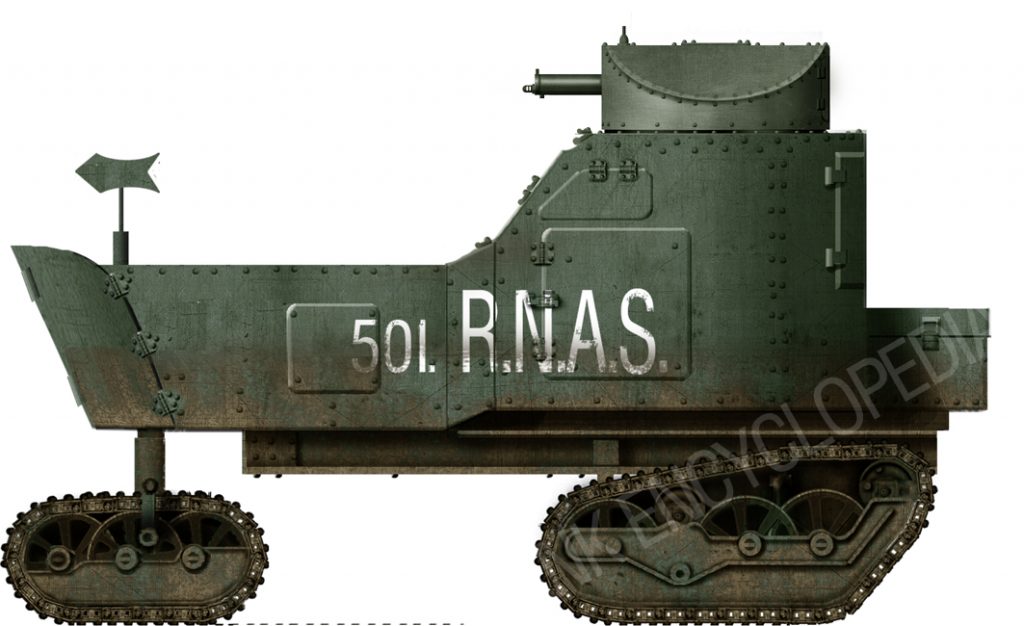 United Kingdom (1917-1918)
United Kingdom (1917-1918)
Armored Tractor – 1 Prototype Built
A first tank contender
The Killen-Walsh Manufacturing Company made farm tractors. It changed its name to Killen-Strait in 1914, to build the agricultural tricycle Strait’s Tractor, designed by William Strait. Their factory was in Meade Street, Appleton, Wisconsin in the USA. The first version was powered by a four-cylinder Doman engine with a 6 x 7-inch bore and stroke engine that produced 40hp. It was known as the 30-50 model. The later version was called the model 3 15-30 tractor but had a less powerful engine. It was powered by a four-cylinder 4 1/2 inch x 5 3/4 inch bore and stroke Waukesha engine that produced 30hp. It was advertised as being able to pull two or three 14 inch ploughs.
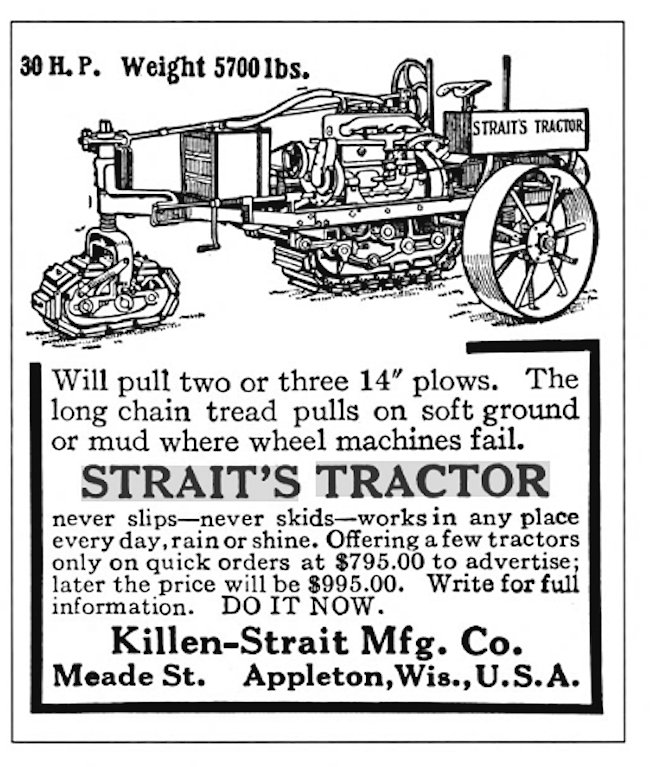
Killen-Straits tractor advertisement – Standard Catalog of Farm Tractors 1890-1980 by C.H.Wendel
It had one caterpillar track at the front and two at the back. The front track was used to steer the vehicle. The two at the rear provided the propulsion. A small directional metal vane was fitted above it, which showed the driver which way the front track was pointing as visibility from the driver’s seat was poor. The tracks were held together with chains and they were made of hardwood. The working surfaces were faced in steel sheets. The links were joined together with case hardened steel pins 1 inch in diameter and 13 inches long. These pins had a bearing surface over their entire length.
The wheels served to keep the track in line, but were not used to transmit any power. The power is positively applied to the track by driving sprockets with detachable case hardened rims. Three links of the chain engage the sprocket at one time, thus minimizing the wear. The chain could be tightened when necessary by moving the front set of idler wheels forward. The links had depressions in them to engage with the drive sprocket teeth.
The steep angle of the tracks at the rear allowed it to reverse over difficult obstacles that were impassable for other tracked tractors. It has been argued that these upward tilting tracks on the Killen-Strait tractor inspired the rhomboid shape tracks on the front of the future British Mark I tank, but others disagree.
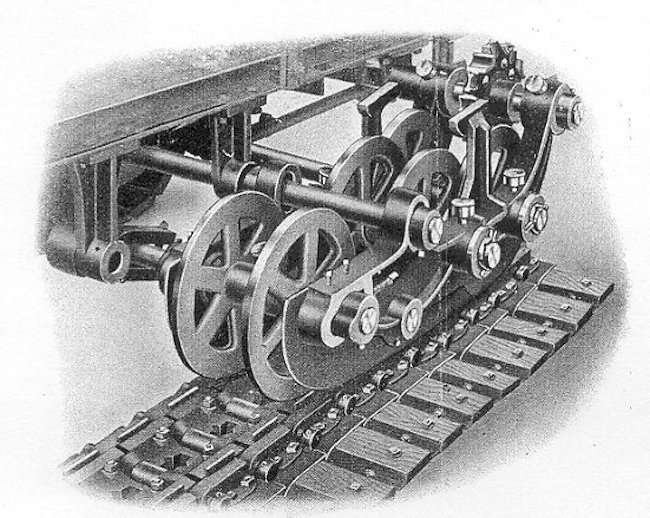
The Killen-Strait tractor tracks were held together with chains and they were made of hardwood
The company’s catalog promoted the following selling point. “One great objection advanced against traction engines has been the way in which they packed the soil. The weight of the Strait Tractor is distributed over 3,000 square inches of bearing surface making the machine exert less pressure per square inch on the ground than a man would…. The strait will run easily and lightly over freshly ploughed ground without packing at all.”
The Strait’s Tractor used a 1914 car type transmission gear box with cut steel, case hardened gears running in a bath of oil. The connection to the engine was via a sliding cone clutch faced with Raybestos. The spur gears had four inch faces and a heavy pitch. They had ample strength to take the strain put on them. There were two speeds forward and one reverse gear.
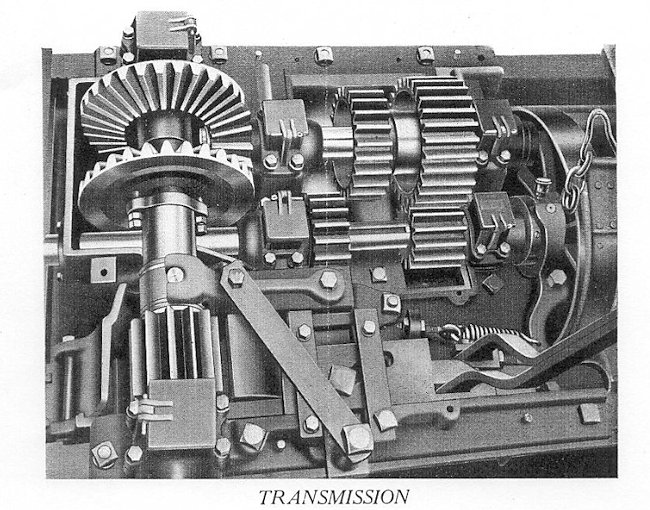
The transmission gear box used in the Strait’s Tractor
On 30 June 1915, Killen-Strait shipped one of their tractors over to London so they could demonstrate its cross country qualities to members of the British Government and Army high command. Winston Churchill, the 1st Lord of the Admiralty and Minister of Munitions, and the future WW1 Prime Minister David Lloyd George were in attendance. Other observers were the Duke of Westminster, Sir Frederick Black (Director of Munitions Supply), Major General Sir Ivor Phillipps, Major General Scott-Moncrieff, Col Holden, Brigadier General Louis Jackson (Head of Trench Warfare at MoM). Jackson later went on to support Swinton and Tulloch demonstrate the American Holt tractor. The demonstration happened at the Talbot Recreation Ground adjoining to the Royal Naval Air Service (R.N.A.S.) Armoured Car Division H. Q., Clement Talbot Works, Barlby Road, Wormwood Scrubs, London.
Churchill was on the lookout for a caterpillar track fitted vehicle that could cross enemy trenches and destroy all wire entanglements. The Ministry of Munitions were looking for a vehicle that could cut the ‘no-mans land’ battlefield barbed wire.
On the same day, the British War Office issued its specification for a ‘machine gun destroyer’ to the Admiralty’s Landships Committee, based at 83 Pall Mall and chaired by Churchill. It is interesting to note that Navy terms were used during the development of the first tanks, not the Army ones. The phrase ‘machine gun destroyer’ can be interpreted in two ways. One is that it is a vehicle that kills machine gun nests and the other is it is a vehicle like a fast agile navy destroyer class ship armed with machine guns. Early tanks were known as Landships.
Lt. Oliver Thorneycroft fitted two scissor-like Royal Navy torpedo net cutters at the end of two protruding shaped metal poles, to the front of the Killen-Strait tractor. The machine was driven into a cat’s cradle of tensioned barbed wire that for demonstration purposes had been prudently strung up at precisely the cutters height. It did not work so well on randomly spaced barbed wire at different heights.
The trials were not successful for the Killen-Strait Manufacturing Company. Although it had good mobility and could negotiate many obstacles put in its way, it was not powerful enough to rip through barbed wire and drag it out of the way to create a path for infantry. When the wire cutter was fitted to the front of the vehicle it took too long to cut the wire and sometimes it failed to cut the barbed wire.
Lt. Symes fitted a turretless Delaunay-Belleville armored car hull onto the tractor chassis. A standard armored car turret could have been fitted at a later date. It was envisioned that this new vehicle would join the ranks of the RNAS Armoured Cars. It made the vehicle very top heavy and gave it a very high profile. This would have made it an easy target for German gunners to see. The main reason the Killen-Strait Tractor did not enter production as a Landship tank was that it could not cross wide trenches.
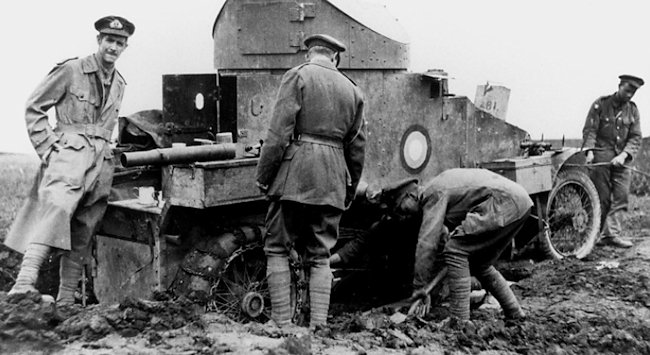
Royal Naval Air Service armored car stuck in the mud in Belgium 1915
The Royal Naval Air Service (RNAS) Armoured Car Section was formed for fleet reconnaissance, patrolling coasts for enemy ships and submarines, and attacking enemy coastal territory. To cover the great distances along the cost they used armored cars but they found the poor conditions of French and Belgium roads limited their activities. They saw in the Killen-Straits armored tracked tractor a vehicle they could use to get to locations where there were no roads or the roads were in very bad conditions. As the unit grew it was renamed the Royal Naval Air Service Armoured Car Division (RNACD) and spilt into 20 squadrons. In the summer of 1915, the RNACD was disbanded as trench warfare developed.
The armored Killen-Strait Tractor ended its days as a tow tractor at the RNAS Barrow Airship Station. It arrived there in September 1915.
R.N.A.S. Armoured tracked vehicle line drawings
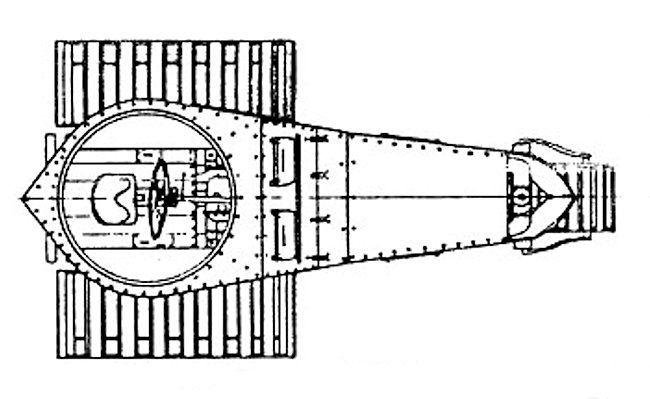
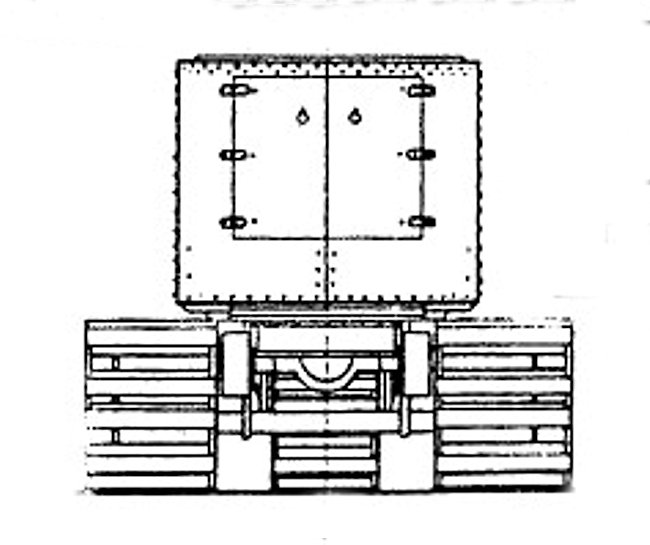
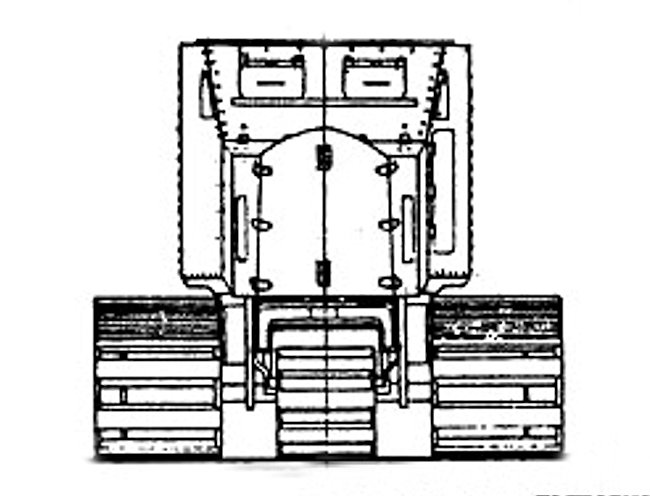
Sources
Imperial War Museum London
Standard Catalog of Farm Tractors 1890-1980 by C.H.Wendel
The Devil’s Chariots: The origins and secret battles of tanks in the First by John Glanfield

Illustration of the Killen-Strait Tractor by David Bocquelet
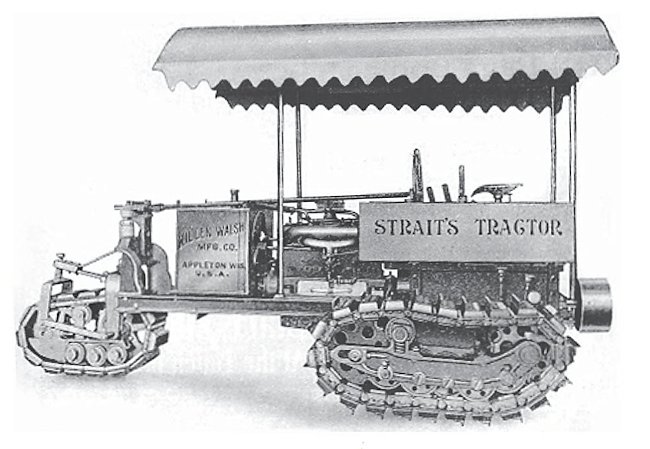
Strait’s agricultural farm tractor with sun canopy fitted
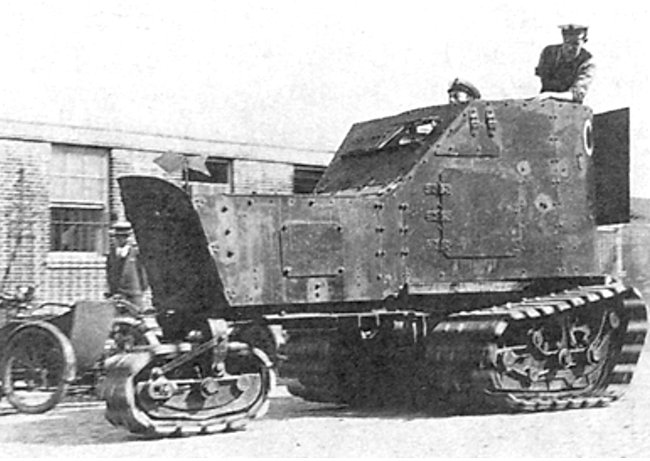
Delaunay-Belleville armored car hull fitted onto the Strait’s tractor chassis. You can see it was open topped. A turret could be fitted later if required.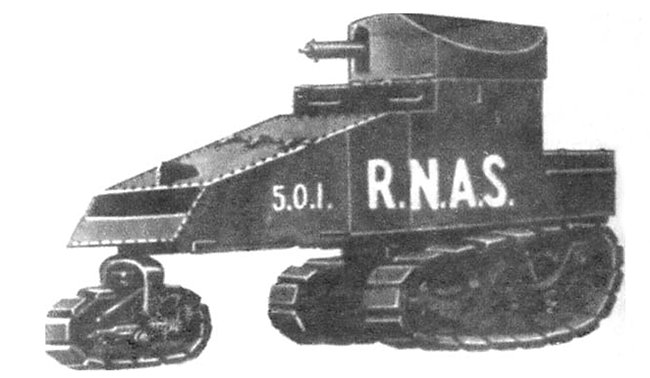
Artists impression of the fully tracked Killen-Strait armored tracked vehicle with turret for use in the R.N.A.S. 501 Armoured Car Squadron.
Movement trials
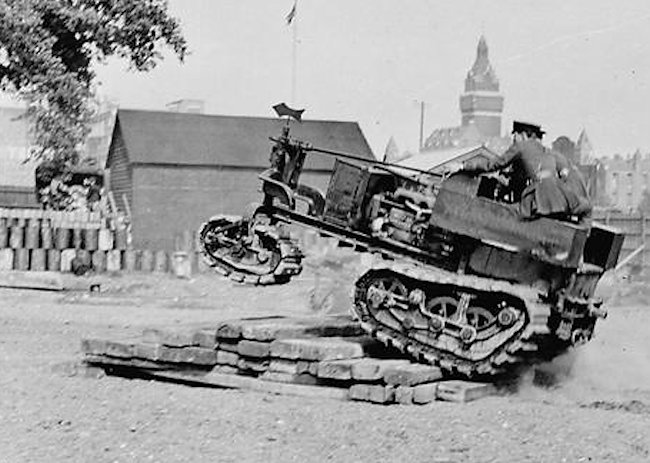
Killen-Strait Tractor during the experiments at Wormwood Scrubbs, June 1915. (IWM Q14618)
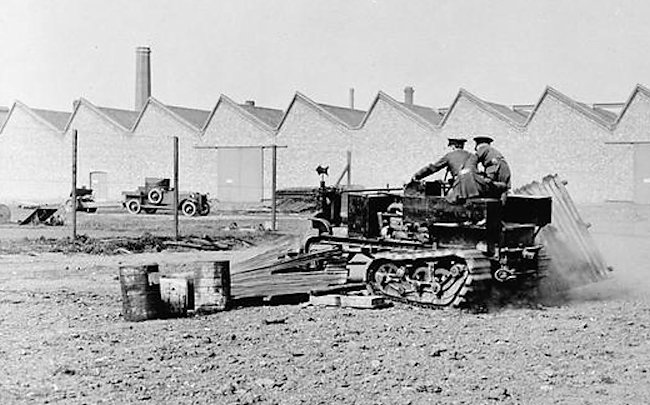
Experiment with the Killen-Strait Tractor at the R.N.A.S. Armoured Car Division H.Q., Wormwood Scrubbs, June 1915. (IWM Q14619)
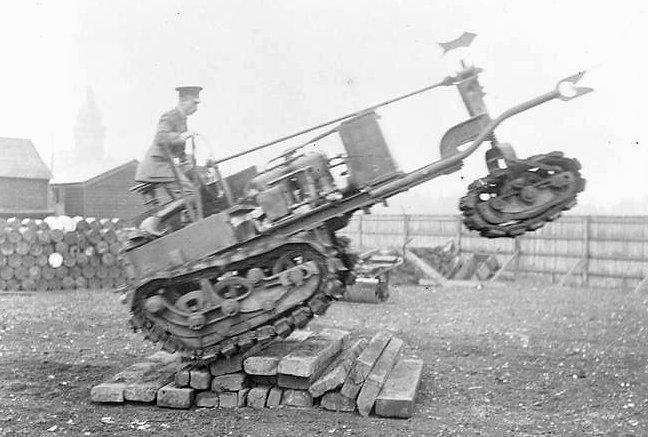
Killen-Strait Tractor at the Armoured Car Headquarters at the Clement Talbot Works, Barlby Road, Wormwood Scrubs. Summer 1915. It is fitted with only one Royal Navy torpedo net wire-cutter, at the end of a metal pole protruding from the front of the vehicle. Later a second wire cutter was added on a separate pole. (IWM Q14616)
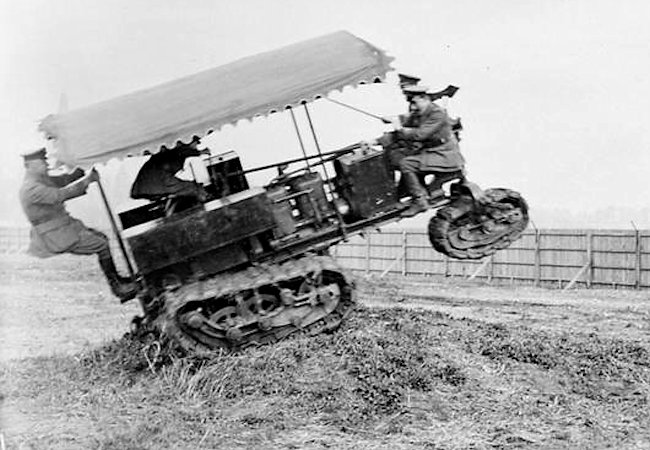
Killen-Strait Tractor negotiating slightly rough ground during experiments at Wormwood Scrubs, June 1915. With human ballast in place, the little Killen-Strait tractor leaps over a grassy mound in the grounds. (IWM Q14620)
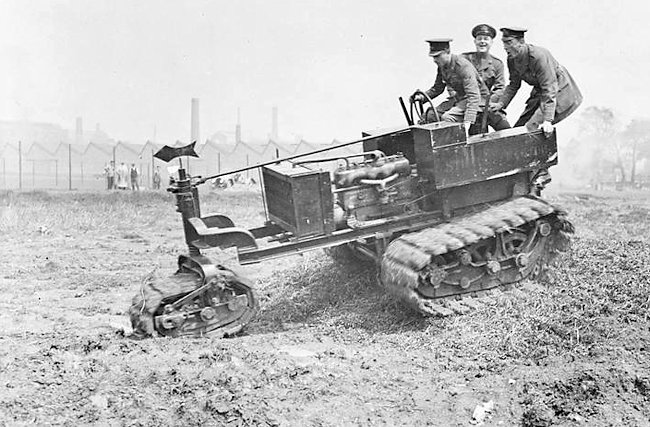
Experiments by members of the 20th Squadron R.N.A.S, with the Killen-Strait Tractor, at Wormwood Scrubs, 30th June 1915. Here they tried to see if more weight at the back of the vehicle would help improve performance. (IWM Q14617)
Barbed Wire dragging and cutting trials
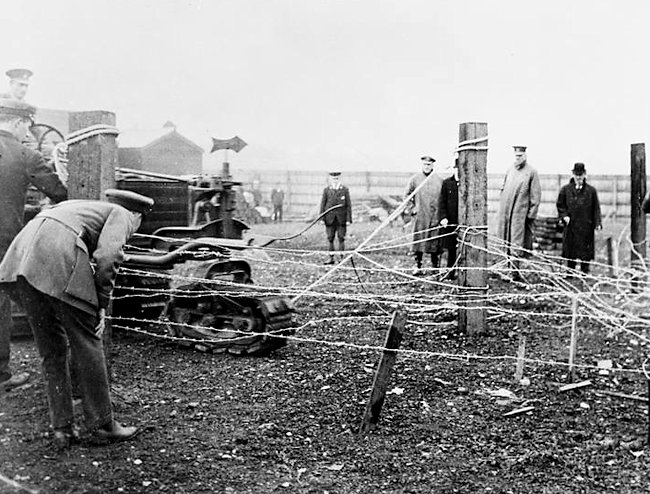
Mr. Lloyd George and Mr. Winston Churchill watching experiment with Killen-Strait Tractor, fitted with only one Royal Navy torpedo net wire-cutter, at the end of a metal pole protruding from the front of the vehicle at Wormwood Scrubs, 30th June 1915. The two officers are Major-General Scott Moncrieff and Colonel W. D. Bird (IWM Q14614)
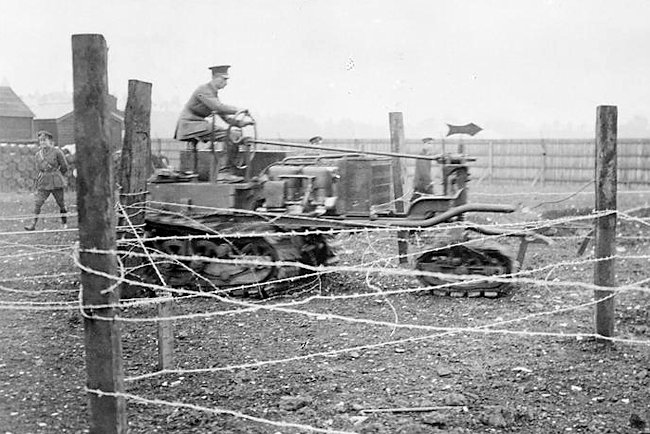
Killen-Strait Tractor fitted at the front with an extra Royal Navy torpedo net wire-cutters at the end of two protruding shaped metal poles at Wormwood Scrubs, 30th June, 1915. You can clearly see two wire cutters fitted at different heights. (IWM Q14615)
Company catalogue Artwork
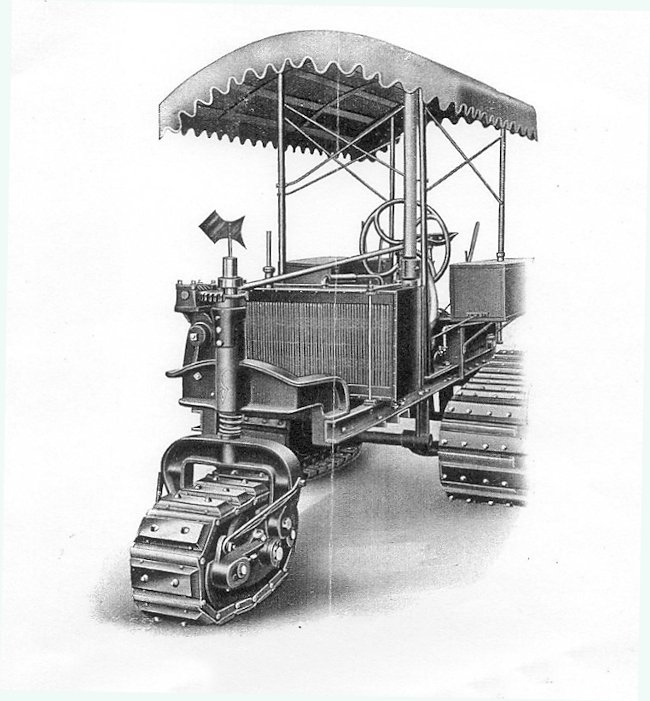
The Strait’s tractor illustration from the Company’s advertising catalogue.”
Straits Tractor Specifications |
|
| Dimensions (L-W-H) | 13ft x 8ft x 6ft (no canopy) |
| Track width | Three choices 18in, 24in or 30in |
| Total weight | 9,500lbs |
| Top Road Speed | 4 mph |
| Fuel capacity | 30 gallons US |
| Propulsion 30-50 model | four-cylinder vertical four cycle Doman 50 hp engine |
| Propulsion 15-30 model | four-cylinder 4 1/2 inch x 5 3/4 inch bore and stroke Waukesha 30hp engine |
By Craig Moore
The First World War’s fierce battles saw the need to develop military technology beyond anything previously imagined: as exposed infantry and cavalry were mowed down by relentless machine-gun attacks, so tanks were developed. Stunningly illustrated in full colour throughout, Tank Hunter: World War One provides historical background, facts and figures for each First World War tank as well as the locations of any surviving examples, giving you the opportunity to become a Tank Hunter yourself.

